A few day trips ago, I wondered what exactly San Francisco had done to deserve its progressive/peacenik reputation. You know, something longer lasting and perhaps a bit more influential than staging a Human Be-in.
Today’s day trip is the result of my research into that question. It turns out San Francisco has a lot to do with progressive causes! Also true to form, its civil rights history isn’t the kind easily packaged. Actually, most of it is still being debated over 100 years later – from “anchor babies” and prisoners in Guantanamo, to Arizona’s recent attempts to curb illegal immigration. San Francisco, and by extension California, has done all of that and more.
Since San Francisco’s civil rights history is so complex, I’ve decided to focus today simply (ha! simply) on civil rights cases that took place here but had national ramifications. They are mostly cases that have been decided by the Supreme Court.
Get ready for my most thought-provoking day trip yet.
On Foot: A Civil Rights Tour of San Francisco (2.5 walking miles, 2 bus miles)
Recommended Itinerary:
- Third and Folsom Street, Site of Yick Wo Laundry
- Walk to 751 Sacramento Street
- Pass by the Chinese Consolidated Benevolent Association Building
- Stop for Sesame Rice Balls at Portsmouth Square Park
- Break for Lunch on Polk Street
- San Francisco City Hall
What You’ll Need:
- Four dollars in bus fare
- Sneakers or comfortable walking shoes
1. Third and Folsom Street, Site of Yick Wo Laundry
Our tour starts with the site of one of the most influential civil rights cases decided by the Supreme Court. The closest BART and MUNI Metro stop is the Montgomery Street stop in downtown San Francisco. (See how to ride BART, and how to ride the MUNI Metro.)
In 1886, Yick Wo operated a laundry at 349 Third Street, just south of Folsom. He had legally emigrated to California in 1861 from China, ten years after California was admitted into the Union, and he had been operating his laundry for 20 years when San Francisco passed Ordinance 1587. The ordinance prohibited anyone in the city from operating a laundry out of a wooden building, finding that wooden laundries could be a fire hazard.
So, it mostly sounds fine, right? Except that at the time, wood was the primary construction material in San Francisco. Roughly 90% of San Francisco was made out of wood, and 97% of the city’s laundries operated out of wood buildings. When the 97% of laundries applied for permits to continue operating their laundries as-is, all 240 Chinese launderers were denied. All petitions by non-Chinese launderers, roughly 70, were approved (well, all except for one, actually). Nothing like simple, dramatic facts to help a court out…
The Supreme Court’s decision basically boiled down to a “are you kidding me?” Or, in their parlance, “can a court be blind to what must be necessarily known to every intelligent person in the State?”
The case is big because it was the first time the Court decided that a law, which was seemingly fair on its face, could be unconstitutional because of how it was applied. It’s been cited in over 150 cases since.
There is nothing about the corner of 3rd and Folsom that helps us envision what it may have looked like in the late 19th Century – probably a row of wooden buildings, with one being arbitrarily singled out. Yick Wo’s wooden laundry is now a 5-story brick-red concrete and glass condo building, across the street from the Comcast offices.
The only wooden building I passed on my way to 3rd and Folsom was Klockar’s Blacksmith Shop, built in 1912. Oddly enough, I suppose this means that the city thought laundries were more of a fire hazard than blacksmiths.
Walk north on 3rd towards Market Street and Union Square. After crossing market, continue walking north on Kearny Street into Chinatown. Turn left when you get to Sacramento Street.
2. 751 Sacramento St, birthplace of Wong Kim Ark
In case you were momentarily feeling a bit warm and fuzzy about our nation’s early civil rights history, the next landmark helps place what happened to Yick Wo in a more informative context. Our next stop is at 751 Sacramento Street, birthplace of Wong Kim Ark.
(751 Sacramento doesn’t actually exist anymore. I assume this is because most of Chinatown was destroyed after the 1906 Earthquake. Instead, we’re greeted with a small school building and an Chinese association building.)
Sometimes, what we consider to be constitutional principles are founded in our idea of the Constitution rather than the Constitution itself. The first week of Constitutional Law in law school is mostly spent disentangling those two ideas. Even our notion of what it means to be “unconstitutional” has very little foundation in the Constitution itself – the Court only decided in 1803 that it had the power to negate laws. It’s not written anywhere in the Constitution.
Similarly, our modern assumption that a child born in the United States is by default an American citizen wasn’t always the case. The 14th Amendment, adopted in 1868, specifies that all persons born in the United States are citizens of the United States. This was a necessary amendment after Dred Scott, an 1857 decision by the Court that African Americans, born in the US, were not American citizens. (The actual decision is even worse than that sentence may lead you to believe.) Despite the seeming clarity of the new Amendment, the Court still had to decipher what exactly it meant.
Wong Kim Ark was born at 751 Sacrament Street, San Francisco, in 1873, to legal, permanent residents of the United States. When he was 21, he left the US to briefly visit China, and wasn’t permitted to re-enter the United States. Customs refused his application for re-entry due to the fact that he was not an American citizen.
The case would appear to be pretty cut and dry, particularly since the Court had already decided that an Irish American-born child was by default an American citizen under the 14th Amendment. But, the Court had to go to great lengths to defeat the arguments made by the United States that Chinese descendants could not possibly be subject to the 14th Amendment. The US had to figure out a way to argue that the Amendment applied to British, Irish, and French American-born children, but did not apply to Chinese American-born children. You can kind of imagine the legal acrobatics that ensued.
In the end, the Court systematically rejected all of those arguments and found Wong Kim Ark to be a legal citizen of the United States, and permitted that citizens of the United States could be “dual citizens” of two nations.
Also interesting is that this case has suddenly gotten very popular. The Times has only referenced it 13 times ever, and the majority of those articles have been printed in the last year. If you Google “Wong Kim Ark,” you’ll find yourself immersed in websites questioning the birthplace of the President. This case is, oddly, hot again.
Walk west on Sacramento Street and turn right on Stockton.
3. Pass by the Chinese Consolidated Benevolent Association Building
The Chinese Consolidated Benevolent Association, or Chinese Six Companies, building is fantastically ornate, and a building that is at once very well known to anyone who has visited Chinatown. However, not many people seem to know anything about it or the Association.
The Chinese Six Companies is a misnomer of sorts – it’s not actually related to any commercial companies. Instead, it was built as an association of people based on common ancestral regions and surnames. In other words, it has more in common with the Daughters of the American Revolution than the Chamber of Commerce.
The association was a critical component of civil rights cases throughout California, perhaps none more important than its attacks on the Geary Act. Six years after Yick Wo’s victory and 6 years before Wong Kim Ark was declared an American citizen, the U.S. Congress passed the Geary Act, a law written and introduced by a California congressman. The Geary Act require all people of Chinese descent to register themselves with the U.S. government (whether they were citizens or not). From then on, all Chinese people would have to carry their certification papers with them at all times or be subject to deportation. An additional provision of the statute specified that only a “white witness” could provide testimony that the accused was a legal citizen/resident.
The association lobbied heavily against the bill, and later on led a nationwide boycott, urging Chinese people to turn their backs on registering under the act. It also raised the funds needed to hire the best lawyers in the country to take the case directly to the Supreme Court.
The case itself was almost a formality. The perfect plaintiffs were found – legal, permanent residents of the United States, who had never violated any laws, and living in New York. One of the plaintiffs intentionally brought forward only a legal, permanent, Chinese resident to vouch for his legality.
SO! You’re probably wondering what our post-Civil War, post-14th Amendment, post-Yick Wo Supreme Court did about this one. They thought it was fine! The opinion is kind of muddled, as tends to be the case when the Court is issuing a questionable opinion. In the end, they decided that the statute didn’t deprive anyone of life, liberty or property, without due process of law – the fact that a person of Chinese descent was allowed to plead his/her case to a judge before being deported meant that there was due process.
As for the whole “white witness” thing – bear with me on this shoddy reasoning. The Court explained that this was nothing new, that it had been in the naturalization laws for 77 years the naturalization process required an oath by a citizen of the United States. So, basically, American citizen, white person, no difference. The Court hypothesized that maybe legislators wanted only white witnesses because of the “loose notions entertained by” Chinese witnesses for the “obligation of an oath.”
Well. At least this case ends up making Arizona’s new immigration laws seem a bit less draconian, I guess. There’s only one more case in Chinatown, and I’m sorry to say it isn’t any more uplifting.
4. Former site of the San Francisco County Jail, 750 Kearny
From Stockton St, turn left onto Clay St. At Grant, you can either continue on to Portsmouth Square ahead of you or take a quick left onto Grant to grab some snacks to enjoy at the park.
I recommend heading to Eastern Bakery, on the corner of Grant and Commercial, between Sacramento and Clay St. This stretch of Grant is the heart of touristy Chinatown, and so decorated to the fullest with hanging lanterns and flags. Also take note of the Banksy mural on the side of Eastern Bakery, now lovingly preserved by the bakers under plexiglass (there were a few incidents). Inside, there’s a never ending display of Chinese pastries, but I recommend the Red Bean filled Sesame Rice Ball. Our rice balls were warm and perfectly gooey and crispy. I highly recommend them.
If you’re looking for something more savory, head down to Anna Bakery on Clay Street right across from the Square.
Armed with your snacks, head into Portsmouth Square. Portsmouth Square, built in the early 1800’s, was the first public square built in San Francisco. Today, it is a bustling urban park – groups of men line each of the park’s available tables, benches, and walls, deep in concentration over Chinese chess boards. Children run between Cherry trees and monkey bars; older kids ride their skateboards along the pedestrian bridge connecting the square to the Hilton. All of Chinatown looms around you.
This next landmark takes us out of the 1800’s and into the mid-1900’s, in the months after the attacks on Pearl Harbor. Troops had flooded into San Francisco, keeping 24 hour look out over the Pacific Ocean, while black out rules were in effect at night. Remember how we felt after 9/11; it was truly a frightening time.
President Roosevelt decided to issue Executive Order 9066, which gave the Army the authority to exclude any and all persons from military areas. (It is so facially neutral that it almost sounds reasonable – thank you, Yick Wo!) The Army, in turn, decided that “persons” in this case were all people of Japanese ancestry. “Military areas” included the entire West Coast from Washington to southern California, and including parts of Arizona. It wasn’t exactly a minor undertaking, with nearly 77,000 American citizens being moved to internment camps.
Fred Korematsu was born in Oakland in 1919. He was 23 in 1942. Mr. Korematsu tried to go into hiding to avoid the internment camps, going so far as to have plastic surgery on his eyes so that he could pass off as Hispanic or Hawaiian. Despite his efforts, he was soon arrested in San Leandro and brought to jail in San Francisco.
I haven’t been able to track down exactly which prison Mr. Korematsu was held in, but my research into which prisons were in operation at the time lead me to believe he was kept here at 750 Kearny. As you can see, 750 Kearny is now a 27-story Hilton Hotel. The Hall of Justice was demolished in 1968.
With the help of prominent civil rights lawyers from San Francisco, Mr. Korematsu’s case eventually went to the Supreme Court. The Court tends to give the Executive Branch a bit more leeway during war time, and Mr. Korematsu’s case was no different. The Court determined the exclusion order was necessary to prevent “espionage and sabotage,” and found that the government satisfied the strict scrutiny test for racial discrimination – the first time the government had passed the Court’s strict scrutiny test. But, this decision was issued the same day as another Japanese internment case, and that decision held that American citizens could not be detained without cause. This is an example of the Court hedging its bets.
This is all particularly interesting to me after all my research into Fort Cronkhite, in the Marin Headlands. In the months after Pearl Harbor, the US really was in a panic that the West Coast was going to be bombed any day by the Japan. However, Fort Cronkhite abandoned its lookout orders by the fall of 1942, acknowledging that no Japanese attacks were coming. The internment camps lasted until 1945.
Indeed, in 1983, a San Francisco federal judge found Mr. Korematsu’s case invalid after a legal historian found that the government had included “intentional falsehoods” regarding the security threat posed by the Japanese. Federal intelligence agencies had already found that Japanese Americans posed no threat to the United States, but the government withheld that evidence in court. January 30th is now Fred Korematsu Day in California, the first US holiday day to be named after an Asian American.
Similar to the cases we’ve already discussed today, Korematsu is newly relevant due to the Guantanamo cases brought before the Court. Before his death in 2005, Mr. Korematsu filed amicus briefs with the Court warning that history was in the process of repeating itself.
5. Break for Lunch on Polk Street
Midway through this tour, you may be feeling a bit pensive. It might be a good time to take a break and grab some lunch.
We decided to go to Polk Street as a transit midway point between Chinatown and our next stop at City Hall. From the park, walk back to Grant Street and take a left. At Pacific St, take a slight left to stand on the corner of Pacific and Grant. You’ll see an utility pole painted yellow, indicating a bus stop. You can either board the 10 or 12 bus, which will take you up and over Nob Hill and onto Polk Street. (See here for how to ride the bus.)
Take the bus to Polk Street and hop off. For lunch, we opted for burgers at Toast, on the corner of Polk and Sacramento St. Another good option, if it isn’t bustling, is another sort of San Francisco landmark — Swan Oyster Depot on Polk between California and Sacramento. (It’s closed on Sundays and only open until 5:30pm otherwise.)
After lunch, walk along the vintage and home decorating shops on Polk St until you are ready to visit the last landmark of the day. Pick up the Muni 19 bus at the bus stop at Polk and Pine St, on the west side of the street. Hop off at the City Hall complex at Hyde and McCallister.
6. San Francisco City Hall
I am including San Francisco City Hall because it may one day be a national civil rights landmark. Back in early 2004, same-sex marriage had just begun making legal in-roads. The Massachusetts Supreme Judicial Court had just ordered the state to start performing same-sex marriages, beginning in May. The Presidential campaign was heating up, with Democratic candidates vying for the nomination. It was the hot topic that no Democratic candidate wanted to touch.
Enter Gavin Newsom, new mayor of San Francisco. On the east coast, we’d heard of him mostly because of how very young and dashing he was. Until he started marrying same sex couples in San Francisco City Hall in February, only a month after his inauguration. That pretty mayor turned out to have some bite. I can’t even convey the sense of delightful anarchy this gave 24-year-old me.
The first gay couple to marry in the United States were Del Martin and Phyllis Lyon, a couple for 51 years. Thousands of people followed. The Time reported that “San Francisco’s City Hall has been turned into a marriage parlor.” Newspapers and news reports were flooded with photos of celebratory couples in and outside of City Hall.
Mayor Newsom was operating, as you could very accurately say, somewhat outside of the law. A California law at the time explicitly stated that marriage could only be between a man and a woman. Mayor Newsom had decided that the law was unconstitutional, according to the California Constitution.
A month after Ms. Martin and Ms. Lyon married, the California Supreme Court ordered San Francisco to stop. Within months, it had also declared the marriages void. The California Supreme Court didn’t take on the constitutionality of the law, but it did decide that Mayor Newsom had acted outside his authority.
Since 2004, same-sex couples have had occasional reason to flood to San Francisco City Hall to obtain marriage licenses, hoping to get in before a court halts them. Proposition 8, voted on in 2008, is the latest ban to same-sex marriage, this time inserted into the California Constitution. California is currently waiting on a ruling by the California Supreme Court on whether the new California Constitutional provision violates the US Constitution. The hearings were televised nationally, and most pundits are guessing that this will most likely be the first same-sex marriage case to reach the Supreme Court.
Once again, San Francisco is comfortably, and deservedly, in the civil rights limelight. Like no other city I’ve lived in, this city seems to thrive on provoking the nation. That’s all fine and well, though, since I get a feeling the nation similarly gets a kick out of our passionate city by the bay.
After roaming the City Hall grounds, you can either head west to Hayes Valley for a post tour coffee or head south for the BART and Muni Metro stop at Van Ness to take you home.







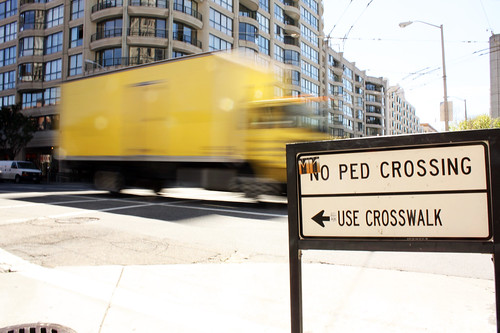

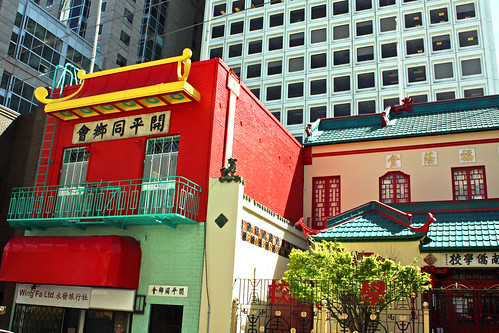
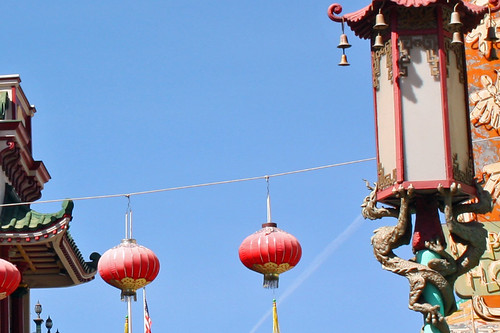


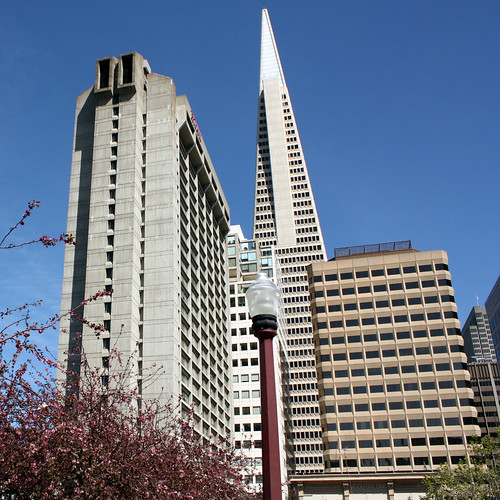
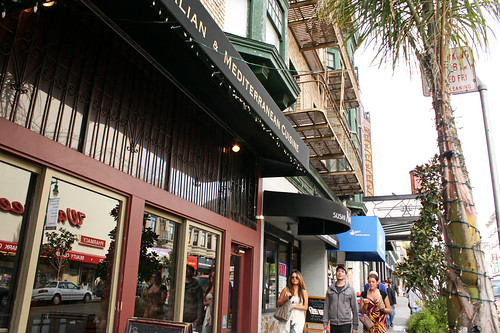
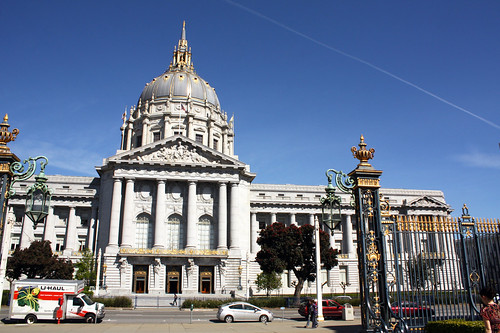

On Foot: Afternoon at the San Francisco Zoo and Sunset at Ocean Beach | Far Out City
[…] Americans have a very long and troubled history in San Francisco and the state. Early delegates to the California state constitution wanted to create the first […]
12/12/2011 at 4:20 pm
Photo of the Day: Broke | Far Out City
[…] featured this as part of my Civil Rights Tour of San Francisco, back in April. I always liked how this photo shows a quieter side of Chinatown — the muted […]
12/23/2011 at 9:58 am